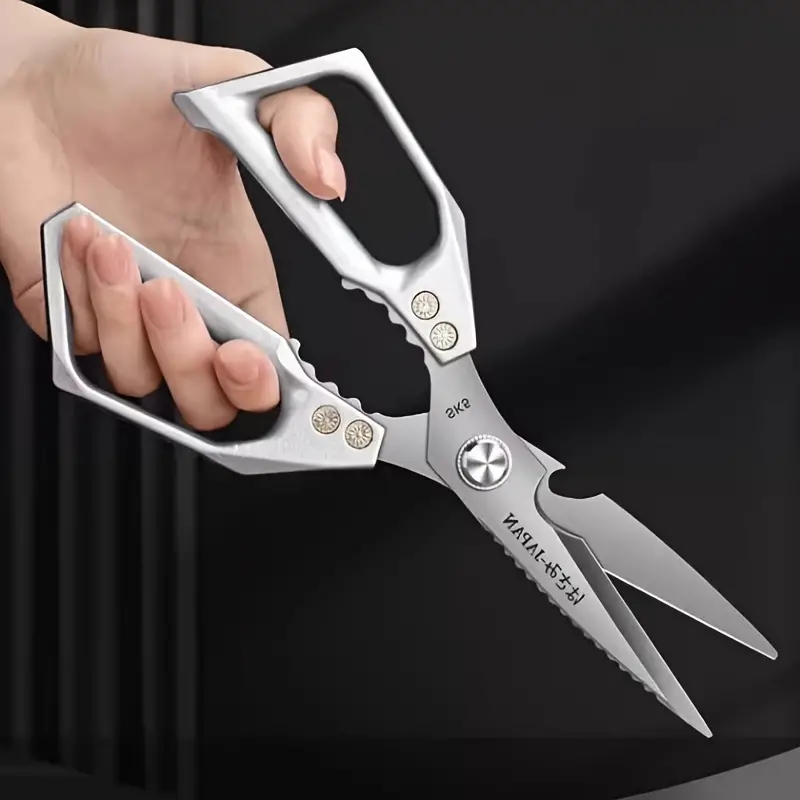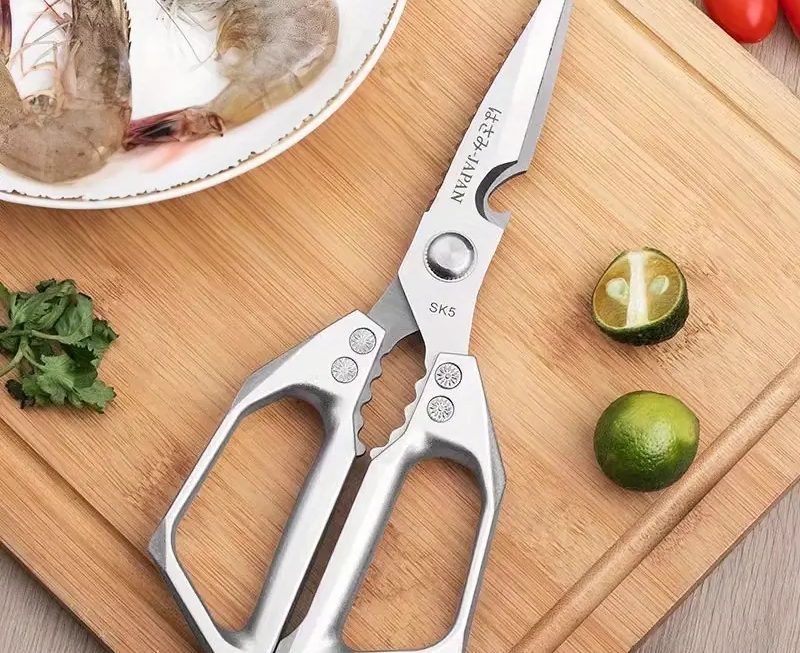Introduction to Sharpening Kitchen Shears
Do your kitchen shears struggle to cut smoothly? Over time, scissor blades become dull and less effective. Using a pair of dull kitchen shears can be frustrating, especially when you’re trying to prepare food quickly and safely. Fortunately, sharpening kitchen shears is a straightforward task that you can often do at home, without the need for professional help. In this blog, we cover five simple methods that explain how to sharpen kitchen shears, ensuring they regain their cutting efficiency.
From basic household items to specialized tools, you’ll learn techniques that can transform your blunted shears into sharp tools once again. These methods will not only enhance the functionality of your kitchen shears but can also extend their lifespan, making them feel like new. Grab your dull shears, and let’s dive into the process of bringing their edge back to life!

Method 1: Using Sandpaper
Step-by-Step Guide
Sharpening kitchen shears with sandpaper is an easy fix. Here is a simple guide to get you started:
- Get the Right Grit Sandpaper: A sheet between 150 and 200 grit works best.
- Fold the Sandpaper: Bend it so the rough sides are out and smooth sides touch.
- Start Cutting: Take the dull shears and snip through the sandpaper 10 to 15 times.
- Ensure Full Contact: Make sure the entire blade edge runs through the sandpaper.
- Repeat If Needed: If the shears are not yet sharp, keep cutting through the sandpaper.
- Clean Up: Wipe the shear blades with a dry towel to remove any residue.
This method leverages materials you likely have at home, making it a convenient option for quickly restoring the sharpness of your kitchen shears. With each snip, the abrasive surface of the sandpaper grinds away tiny imperfections, honing the shear blades to a finer edge.
Method 2: Using Aluminum Foil
Detailed Instructions
Sharpening kitchen shears with aluminum foil is a quick and budget-friendly method. Here’s how to do it:

- Obtain Aluminum Foil: Grab a piece at least 10 inches long.
- Fold the Foil: Fold it lengthwise multiple times to create a thick strip.
- Cut Through the Foil: Use your dull shears to slice the foil strip 10 to 20 times.
- Ensure Full Blade Contact: Make sure the entire cutting edge runs through the foil.
- Repeat for Extra Sharpness: If needed, keep cutting until you’re satisfied with the sharpness.
- Clean the Blades: Wipe them with a towel to remove foil residue.
By cutting through the layered foil, you effectively hone the beveled edge of your kitchen shears. Each slice scrapes away bits of metal, sharpening the blades. This method is surprisingly effective and uses an item commonly found in most homes. Remember to clean your shears after sharpening to ensure they’re ready for use.
Method 3: Using a Glass Bottle or Mason Jar
How to Execute the Technique
Believe it or not, a glass bottle or mason jar can sharpen kitchen shears effectively. Here’s how to put this technique into practice:
- Find a Suitable Bottle: Pick out a glass bottle or mason jar with a smooth edge.
- Steady the Bottle: Firmly hold the bottle with your non-dominant hand.
- Start Cutting: Open the shears and position one of the blades along the top edge of the bottle.
- Slide the Blade: Drag the blade along the bottle edge, using a swift cutting motion.
- Repeat the Motion: Do this 15 to 20 times for each blade.
- Test Sharpness: If needed, go over the edge a few more times until they’re sharp.
- Clean the Shears: Use a dry towel to wipe off any glass residue.
With each pass, the glass edge helps to realign and smooth out imperfections on the shear blade. This method is especially handy because it uses an item you likely already have at home. Just ensure to handle the glass carefully to prevent breakage.
Method 4: Sharpening with a Whetstone
Process Overview
Sharpening kitchen shears with a whetstone is a traditional and effective technique. Here’s a quick overview of the process:
- Place Whetstone on a Flat Surface: Set your whetstone on a towel to prevent slipping.
- Separate Shear Blades (Optional): You may detach blades for an easier sharpening experience.
- Identify the Beveled Edge: Each blade has a side that is angled; this is where you sharpen.
- Begin Sharpening: Slide each blade across the stone, maintaining the blade’s angle.
- Count Your Strokes: Repeat the movement up to twenty times per side.
- Turn Whetstone Over: Use the finer side of the stone for finishing strokes.
- Clean Blades: Always wipe down your shears after sharpening.
This method might require practice to master the blade’s angle and pressure needed.
Fine-Tuning with the Whetstone
Once you’ve sharpened with the coarse side, fine-tune your blades on the fine side. Here’s how:
- Flip the Stone: Ensure the fine side is up.
- Light Strokes: Glide each blade across five times.
- Check Sharpness: Test the shears to see if they meet your standards.
- Wipe Clean: Remove any remaining stone dust from the blades.
The whetstone’s fine side perfects the edge, achieving a sharpness that’s ideal for kitchen tasks. Remember to keep the whetstone wet if required, according to its type.

Method 5: Employing a Rotary Tool
Preparations and Precautions
Before you begin sharpening your kitchen shears with a rotary tool, ensure you have a secure setup. Here’s what you need to prepare:
- Set Up a Stable Work Area: Choose a flat, sturdy surface.
- Secure the Shears: Use a vise or ask someone to hold the shears firmly.
- Check the Tool: Make sure the rotary tool is in good working condition.
- Wear Safety Gear: Put on protective eyewear.
Taking these precautions helps prevent accidents and ensures a smoother sharpening process.
Sharpening Steps with a Rotary Tool
Using a rotary tool for sharpening kitchen shears can be quite effective. Follow these steps:
- Install the Right Attachment: Choose a grinding or sharpening bit.
- Position the Shears Correctly: Blades should be upright, tips pointing upwards.
- Adjust the Tool’s Speed: Set it to a low or moderate speed.
- Start Sharpening: Begin with the beveled side of the blade.
- Apply Gentle Pressure: Move the tool along the blade’s edge.
- Count Your Passes: Keep track to ensure both blades get equal treatment.
- Test and Repeat: Check sharpness; if necessary, go over the blades again.
- Clean the Blades: Use a cloth to wipe away any metal filings.
This method helps maintain the blade’s edge and increases the shears’ lifespan. Remember to handle the rotary tool with care to avoid damaging the shears.
Tips for Effective Shears Sharpening
Sharpening kitchen shears can be simple with the right tips. Below, find three key pointers to help sharpen effectively:
Sharpen Both Blades Evenly
For balance, sharpen each blade the same amount. This ensures even wear and better function. Count strokes or passes so both blades get equal attention. For good outcome, don’t favor one side.
Getting the Beveled Angle Right
The angle is crucial for sharpness. Kitchen shears have a slanted, beveled edge. When sharpening, match this angle closely. If you miss the angle, you might not sharpen well. A consistent, correct angle keeps the edge sharp.
Cleaning the Blades After Sharpening
After sharpening, always clean the blades. Wipe off the metal dust and particles. For this, use a dry towel or cloth. You can also cut cardboard to remove tiny burrs left on the blades. This step is vital for clean, sharp shears ready to use.
Follow these tips to get sharp kitchen shears that cut precisely. Keeping shears in top shape is not only about sharpening but also about proper technique and care.
Conclusion on Sharpening Techniques
We’ve looked at five easy methods to sharpen kitchen shears. Each method is effective and can be done at home with basic tools or household items. Whether you use sandpaper, aluminum foil, a glass bottle, a whetstone, or a rotary tool, you can restore the sharpness of your kitchen shears. Remember to follow the steps carefully, maintain the correct angle, and clean your shears after sharpening. With these techniques, your shears will cut efficiently, making your kitchen tasks easier and safer. Keep these tips in mind, and enjoy the benefits of sharp kitchen shears. Thank you for reading, and happy sharpening!



